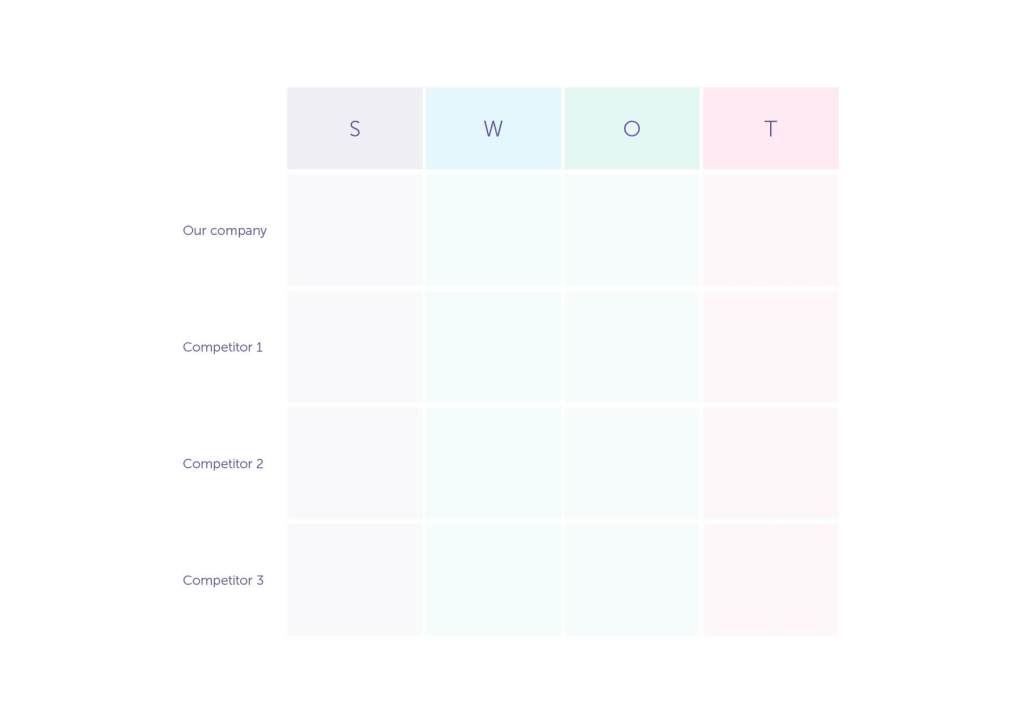Taking the time to do a competitor analysis will help you grow your business and stay on top of market trends. It’s an important part of any business strategy, whether you’re just starting out or are an established brand looking to understand a new competitor.
Learn how to do a competitor analysis and how it can help your small business identify opportunities, develop your products and services, and stay ahead of the competition.
Get your free competitor analysis template
What is competitor analysis?
Competitive analysis, or competitor analysis, is when you take a strategic view of your competitors to understand their products, services, and their marketing and pricing strategies.
Ultimately this is how businesses of any size can try to gain a competitive advantage and continue to attract customers. For example, it can help you answer questions like:
- am I advertising my business in the right places?
- have I priced my products or services fairly and competitively?
- how do my values and strengths compare to my competitors?
- what’s missing from my product or service offering?
- what do I need to do to reach my business goals?
Advantages of competitor analysis
A competitor analysis is a useful way to help you:
- find a gap in the market
- improve or develop new products or services
- inform your marketing and pricing strategy
- take advantage of new industry trends
- keep an eye on new and emerging businesses that could impact your success
What should a competitor analysis include?
A competitor analysis involves researching key information about three or four of your competitors. You should aim to include information on these areas:
- products or services
- features and benefits
- revenue
- marketing
- pricing
- market share
- strengths and weaknesses
- customer reviews
How to do a competitor analysis: step-by-step
1. Identify your competitors
You probably have a good idea who your competitors are, but do you know what sets them apart? If you only take the occasional look at their social media and YouTube channels without digging deeper into their overall strategy, you could be missing out on big opportunities.
The key here is to look at direct competitors that match your business in terms of the products or services they offer, their geographic location, and size. Choose three or four key competitors and give a short overview as part of your analysis, including:
- a short description of each competitor
- revenue – for listed companies this information is publicly available on the London Stock Exchange. This can be harder to find for private companies, but you can check Companies House as a starting point
- date established
- management information
2. Review products and/or services
This is where you should list the features and benefits of your products or services, and compare them in detail with each of your competitors. A good way to do this is to create a simple table that breaks everything down by price, quality, and key features.
3. Analyse their marketing strategy
This section is where you can look at how your competitors are promoting their business to customers. You’ll include things like:
- social media – compare what platforms they use, how often they post, and how much customers are engaging with content
- advertising – do they have printed flyers or posters? If so, where are they?
- content strategy – what’s their website like? Do they keep a blog? Do they showcase customer case studies and testimonials?
- newsletters and emails – sign up to your competitors’ email newsletters if they have one to see how they’re communicating with their customers
- events – see if your competitors are regularly attending trade shows, selling at local market stalls, or putting on events
Read our guide to marketing your small business for tips and download our marketing strategy template to start planning.
4. Pricing
It’s important to regularly analyse your pricing strategy against your competitors so you don’t miss potential threats to your business. A similar business might drop their prices for example, so you need to make sure you’re staying on top of changes in demand and seasonal sales.
It’s not all about price though. Consider how price reflects quality, as well as any shipping and return costs.
5. Customer reviews
Trawling through review sites might seem like a chore, but it can be a fantastic indicator of what your competitors are doing well – and what they aren’t so good at.
Whether it’s reviews on Facebook, Google, Trustpilot, Tripadvisor, or one of the many other sites available, there are plenty of ways to see what customers think of you and your competitors. This can help you understand if there’s an opportunity to improve your service or develop something new that better answers customer needs.
6. Carry out a competitor SWOT analysis
SWOT stands for strengths, weaknesses, opportunities, and threats. Usually you’ll use a grid layout with space to write notes for each section. It’s an important part of writing a business plan, but a SWOT analysis can also be used to see how your competitors are performing based on your perceptions and market research.

Read more about how to do a SWOT analysis and how to do market research.
What is a competitor analysis framework?
A competitor analysis framework is a form of analytical modeling that guides how you’ll structure your competitor research.
We’ve already mentioned SWOT analysis, which is one example of a framework that can help you gain a competitive advantage.
Another example is position mapping. For this model, you’d use a simple chart to plot your perception of your competitors’ products in terms of quality versus price, and how you think your products compare. This can help you understand whether you’re able to demand a higher price if you’re offering a premium product.
Competitor analysis tools
There are so many competitor analysis tools out there it can be overwhelming, particularly if you’re a small business without big budgets and a digital marketing agency at your disposal.
That said, you might like to explore how some of the tools below can help you as you grow. But keep in mind, they’re subscription platforms so you’ll need to decide if the monthly cost is worth it.
- Brandwatch – a social media ‘listening’ tool that provides useful insights into how people are engaging with your brand, and your competitors, across social platforms
- BrightLocal – see how local businesses perform in local web searches and review Google My Business listings
- BuzzSumo – gather new content ideas and an insight into how competitor content performs – you can do a free trial and follow this guide on how to make the most of BuzzSumo in 30 days
- Ahrefs – conduct keyword research for your website or blog and see what your competitors are ranking for
Competitor analysis example
If you’re still wondering how to conduct a competitor analysis, make sure you download our editable template to get started for your business.
This is just an overview of some of the ways you can approach a competitor analysis and is by no means exhaustive. The main thing is to keep it simple and focus on market research to start with, but continue revisiting your analysis and building on it as your business grows.
More guides and resources
- How to write a business plan – and free template
- How to enter business awards
- How to advertise your hair business
- How to start a small clothing business from home
- What type of business insurance do I need?
Do you have any unanswered questions about how to do competitor analysis? Let us know in the comments below.
Looking for self-employed insurance?
With Simply Business you can build a single self employed insurance policy combining the covers that are relevant to you. Whether it’s public liability insurance, professional indemnity or whatever else you need, we’ll run you a quick quote online, and let you decide if we’re a good fit.
